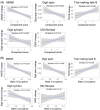Temporal dynamics predict symptom onset and cognitive decline in familial frontotemporal dementia
- PMID: 36377606
- PMCID: PMC7614527
- DOI: 10.1002/alz.12824
Temporal dynamics predict symptom onset and cognitive decline in familial frontotemporal dementia
Abstract
Introduction: We tested whether changes in functional networks predict cognitive decline and conversion from the presymptomatic prodrome to symptomatic disease in familial frontotemporal dementia (FTD).
Methods: For hypothesis generation, 36 participants with behavioral variant FTD (bvFTD) and 34 controls were recruited from one site. For hypothesis testing, we studied 198 symptomatic FTD mutation carriers, 341 presymptomatic mutation carriers, and 329 family members without mutations. We compared functional network dynamics between groups, with clinical severity and with longitudinal clinical progression.
Results: We identified a characteristic pattern of dynamic network changes in FTD, which correlated with neuropsychological impairment. Among presymptomatic mutation carriers, this pattern of network dynamics was found to a greater extent in those who subsequently converted to the symptomatic phase. Baseline network dynamic changes predicted future cognitive decline in symptomatic participants and older presymptomatic participants.
Discussion: Dynamic network abnormalities in FTD predict cognitive decline and symptomatic conversion.
Highlights: We investigated brain network predictors of dementia symptom onset Frontotemporal dementia results in characteristic dynamic network patterns Alterations in network dynamics are associated with neuropsychological impairment Network dynamic changes predict symptomatic conversion in presymptomatic carriers Network dynamic changes are associated with longitudinal cognitive decline.
Keywords: disease progression; frontotemporal dementia; functional magnetic resonance imaging (fMRI); network dynamics; presymptomatic.
© 2022 The Authors. Alzheimer's & Dementia published by Wiley Periodicals LLC on behalf of Alzheimer's Association.
Conflict of interest statement
James B. Rowe is a non‐remunerated trustee of the Guarantors of Brain, Darwin College, and the PSP Association; he provides consultancy to Alzheimer Research UK, Asceneuron, Biogen, CuraSen, UCB, SV Health, and Wave, and has research grants from AZ‐Medimmune, Janssen, Lilly as industry partners in the Dementias Platform UK. Johannes Levin reports speaker fees from Bayer Vital, Biogen, and Roche, consulting fees from Axon Neuroscience and Biogen, author fees from Thieme medical publishers and W. Kohlhammer GmbH medical publishers, non‐financial support from AbbVie and compensation for duty as part‐time CMO from MODAG. Author disclosures are available in the supporting information.
Figures



References
-
- Rohrer JD, Nicholas JM, Cash DM, et al. Presymptomatic cognitive and neuroanatomical changes in genetic frontotemporal dementia in the Genetic Frontotemporal dementia Initiative (GENFI) study: a cross‐sectional analysis. Lancet Neuro. 2015;14: 253‐262. 10.1016/S1474-4422(14)70324-2 - DOI - PMC - PubMed

